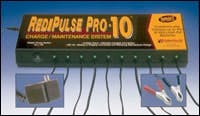Store 10 Batteries in Like-New Condition With RediPulse Pro
PulseTech says sulfation—the buildup of sulfates on battery plates—is the main cause of battery problems and failures.
Batteries make voltage with a chemical reaction. Plates made from dissimilar metal compounds (lead and lead oxide) react in the acidic electrolyte and a flow of electrons moves from negative to positive plates. Active lead and lead oxide in the plates starts changing to lead sulfate. When the discharge stops, a charger or a vehicle alternator pushing current from positive to negative causes the plates to revert to more dissimilar compounds.
As a battery spends more time in a discharged condition, lead sulfate deposits on its plates can enlarge, harden and resist conversion back to electrolyte again. That's sulfation. The difference between the positive and negative plates diminishes. The battery weakens.
"The sulfation buildup process is a natural byproduct of battery operation," says Scott Schilling, vice president of sales and marketing for PulseTech. "Sooner or later—usually sooner—it will kill your battery."
Sulfation accelerates when a battery is stored too long in a discharged condition. Because unused batteries discharge slowly, their effectiveness and life are reduced even while they sit on the shelf if they are not properly maintained.
PulseTech patented the ReNew-IT Pulse technology to prevent sulfate buildup. It emits a pulsating direct current into the battery to remove sulfate from the plates and convert it to active electrolyte. The PulseTech technology is defined by a distinct pulse waveform with a strictly controlled rise time, pulse width, frequency, and amplitude of current and voltage. Cleaning the plates keeps batteries in like-new condition. PulseTech claims clean plates also help stretch battery life up to three times longer.
RediPulse Pro-10 is designed to keep new batteries fresh while they're waiting to be installed. It trickle charges the batteries and prevents sulfation, but it is only effective in reclaiming sulfated batteries if they have a charge level of at least 11 volts. At a manufacturer's suggested retail price of $350, it's an economical way to maintain batteries in inventory.
If you want to recover older, more heavily sulfated batteries, there are PulseTech products designed specifically for reclamation work. The Pulse Recovery System, starting at $1,995, will recover two batteries at a time, and modules that attach to two batteries each can be added on for $325 per module. PulseTech's Pulse Charger (manufacturer's suggested price of $695) combines a 20-amp charger with the pulse recovery system to restore one battery at a time.


